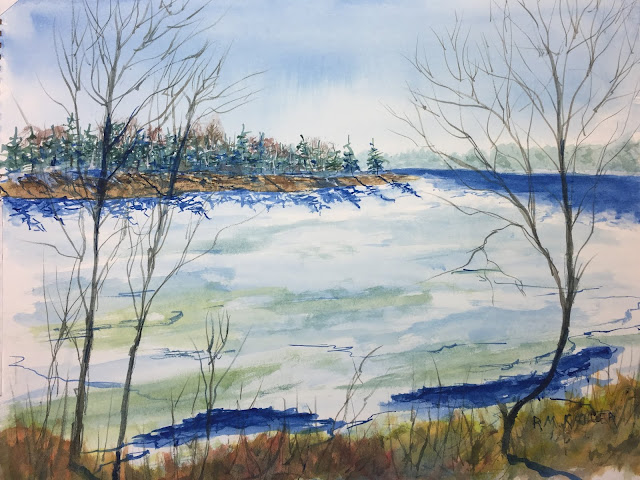This morning started as just one of those mornings. Got out of bed, stepped on the cat, )(the cat's fine), spilled morning coffee - you know the kind of day. Nothing major, just irritating.
Later I took a short ride to see what was happening at the river bend today. It was beautiful. The sun was high, the ice was reflecting the sun, at times making difficult to see, the ice almost silver. There were dark channels of open water working thier way through the ice pack creating a dramatic contrast to the silver ice and the trees were backlit so strongly they had an almost flat appearance.
More striking were the sounds of the day. The wind blowing some stubburn brittle brown leaves which had held on all winter. When the wind held sustained gusts - you could observe the ice rolling ever so slightly, but it was the sound of the ice moving which really was the attention getter.
I did a very brief compositional study in Pen and Ink today. Including a particularly interesting (to me) tree to be included in finished paintings. I acutally spent more time taking some brief observational notes.

I began a large compositional sketch in charcoal a little while ago - just the very beginning of a sketch. Then everything clicked. The past few days of observation plus many random observations over the years.
From this one composition I'm going to do five subjects - which will all be different - and all based on my own observations of nature. My own much simpler version of Monet's haystacks or Cathedrals. Three daylight scences with differnet lighting as observed and two night scenes. Am excited to get started.
The previous day, I'd done some four compositional studies from another vantage point. They are sketchy (no pun intended) but turn out to be great time savers for me. In a matter of minutes I was able to determine that an idea I had for a painting wouldn't really work as I'd envisioned it (rather than finding out at the end of a painting) and then eventually settling on a different composition to explore in more detail later.

Back to why I love painting on location - not simply the artistic problem solving - though that is satisfying by itself. Most of all, the feeling of peace nature instills in me - no matter the day, no matter the time.










